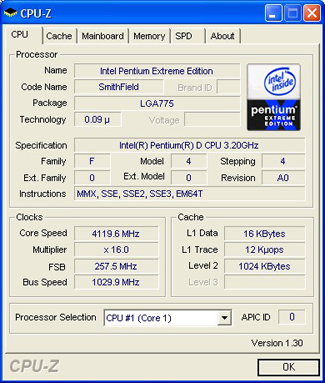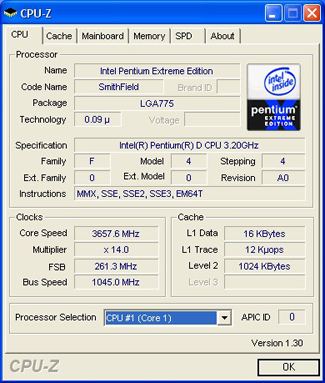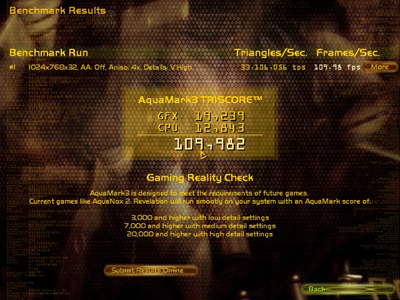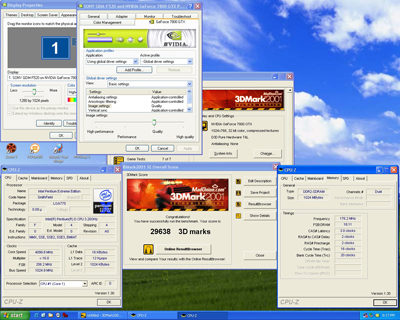Asus P5N32-SLI: Dual x16 - What Dreams Are Made On . . .
by Gary Key on October 27, 2005 12:05 AM EST- Posted in
- Motherboards
ASUS P5N32-SLI Deluxe: Overclocking
FSB Overclocking Results
Memory Stress Testing
Memory stress tests look at the ability of the Asus P5N32-SLI Deluxe to operate at the officially supported memory frequencies of 667MHz DDR2 at the best performing memory timings that the Corsair CM2X512A-5400UL revision 1.3 will support.
The Asus P5N32-SLI Deluxe was completely stable with 2 DDR2 modules in Dual-Channel at the settings of 3-2-2-8 at 2.1V and was stable at this setting up to a timing mode of 720MHz before changing the Command Rate to 2.
We will now install all four available memory slots, which are usually more strenuous on the memory subsystem than testing 2 DDR2 modules on a motherboard.
The Asus P5N32-SLI Deluxe was completely stable with 4 DDR2 modules in Dual-Channel at the settings of 3-2-2-8 and only needed the voltage increased to 2.2. This is an excellent accomplishment and truly shows off the engineering aspects of this board.
FSB Overclocking Results
| Front Side Bus Overclocking Testbed | |
| Processor: | Pentium 4 Prescott LGA 775 840EE Dual Core 3.2GHz |
| CPU Voltage: | 1.4125V (1.3875V default) |
| Memory Settings: | 3-2-2-8 1T at 715MHz |
| Memory Voltage: | 2.1V |
| NorthBridge Voltage: | 1.40V |
| SouthBridge Voltage: | 1.50V |
| Cooling: | Intel 840EE Heat Sink |
| Power Supply: | OCZ Power Stream 520 |
| Maximum CPU OverClock | 257fsb x 16 (4119MHz) +29% |
| Maximum FSB OC: | 261fsb x 14 (3657MHz) +15% |



Memory Stress Testing
Memory stress tests look at the ability of the Asus P5N32-SLI Deluxe to operate at the officially supported memory frequencies of 667MHz DDR2 at the best performing memory timings that the Corsair CM2X512A-5400UL revision 1.3 will support.
| Asus P5N32-SLI Deluxe Stable DDR667 Timings - 2 DIMMs (2/4 slots populated - 1 Dual-Channel Bank) |
|
| Clock Speed: | 200MHz (800FSB) |
| Timing Mode: | 667MHz - Default |
| CAS Latency: | 3 |
| RAS to CAS Delay: | 2 |
| RAS Precharge: | 2 |
| RAS Cycle Time: | 8 |
| Voltage: | 2.1V |
| Command Rate: | 1 |
The Asus P5N32-SLI Deluxe was completely stable with 2 DDR2 modules in Dual-Channel at the settings of 3-2-2-8 at 2.1V and was stable at this setting up to a timing mode of 720MHz before changing the Command Rate to 2.
We will now install all four available memory slots, which are usually more strenuous on the memory subsystem than testing 2 DDR2 modules on a motherboard.
| Asus P5N32-SLI Deluxe Stable DDR667 Timings - 4 DIMMs (4/4 slots populated - 2 Dual-Channel Banks) |
|
| Clock Speed: | 200MHz (800FSB) |
| Timing Mode: | 667MHz - Default |
| CAS Latency: | 3 |
| RAS to CAS Delay: | 2 |
| RAS Precharge: | 2 |
| RAS Cycle Time: | 8 |
| Voltage: | 2.2V |
| Command Rate: | 1 |
The Asus P5N32-SLI Deluxe was completely stable with 4 DDR2 modules in Dual-Channel at the settings of 3-2-2-8 and only needed the voltage increased to 2.2. This is an excellent accomplishment and truly shows off the engineering aspects of this board.











70 Comments
View All Comments
Kensei - Friday, October 28, 2005 - link
I just wanted to say that I REALLY appreciate the wonderful combination of a person who is a very, very good writer and technologist. This extremely rare combination makes him one of the best technical writers I've come across in the past 20 years.It's not too hard to find people who are technically competent but very hard to find someone who can communicate well and knows what the hell they're talking about (ask anyone who has been to college). Quite frankly, he sets a standard that I think all AnandTech writers (ok... all technical writers) should strive to eventually achieve. This level of expertise typically takes years of practice to acquire even among the talented. Can't wait for his next article.
To quote the first post..."Mixing philosophy, classical literature and computer hardware reviews? Gotta love it."
Kensei
Gary Key - Monday, October 31, 2005 - link
I greatly appreciate the comments. This was my third article and hopefully I improve with each one although you have now placed a great deal of pressure on me. ;->The next article series will be a multiple board review. I am learning how to convey several different messages in a very condensed form. It will be different than this last article so I would appreciate comments, good or bad. I try my best to listen to the readers and follow up on suggestions.
I have two very good editors in Wes and Karen so it really is a team effort at AnandTech. I still have a great deal to learn and in fact will be taking a composition course this winter to improve my skills.
Kensei - Thursday, November 3, 2005 - link
You are welcome. I don't think you need a composition course so I'd be interested in hearing how much you learned once it's over. Hopefully I'm wrong, but you may be disappointed by the course. If this is a college course, you may find that people in English departments don't quite get technical writing. It's different (although not totally different) than writing good short stories.Keep up the good work and I look forward to your future articles.
Kensei
screwtech02 - Friday, October 28, 2005 - link
So let me get this straight... In "theory" i can run my 820 at a 250fsb or 4.0, with a ddr700 rating?? And the board will recognize both the cores?? I'm tempted to get this board, but after having the previous one from ASUS, i'm scared to death, it was a HORRIBLE overclocker, max i could get was 230fsb, and lousey mem performance.... But if you say this board is different, i may try one....Gary Key - Saturday, October 29, 2005 - link
Email me please and I can forward some testing results to you along with additional information.NegativeEntropy - Friday, October 28, 2005 - link
Please check your USB/Firewire/Ethernet throughput graphs for their use of MB (MegaByte) vs Mb (Megabit).Nice board :)
Gary Key - Friday, October 28, 2005 - link
I have corrected the charts. Thank you for noticing the issue. Sometimes you view something so much that you miss the obvious. :)noac - Friday, October 28, 2005 - link
I read that you thought most would fit - "an excellent amount of room for alternative cooling solutions". Im wondering more specifically if the Scythe Ninja will fit with/without the optional fans. BTW did you test them, the fans? Wondering how much noise they make and if they work well.Gary Key - Friday, October 28, 2005 - link
I do not have the Ninja although I know where to get one for a test. :) I received the optional fans a couple of days ago from Asus (tried to get them before publishing but it did not work out). I will try them this weekend and respond to your questions. They are designed to be used with watercooling or phase change setups. The stock Intel 840EE cooler (upgraded from other Pentium D units) provided enough air flow in the area to keep the MOFSETs cool. The aftermarket coolers I used provided more than enough air flow and fit great within the CPU area. Let me know if you need a listing of these heatsinks.yacoub - Thursday, October 27, 2005 - link
That's a freakin' awesome (if expensive) board!Btw THANK YOU THANK YOU THANK YOU for finally showing just how greatly sound enabled impacts the framerates on boards with on-board audio. Amazing that 17-19% of your CPU's power can be sapped by a stupid audio chip, especially when that turns into ~15fps drop in some games. Ugh.